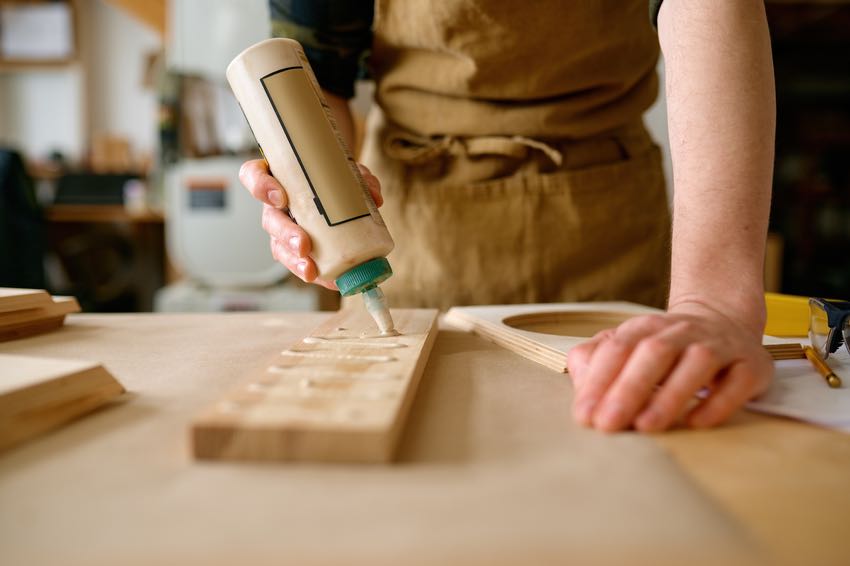Sure, you can use screws and nails to secure two pieces of wood together. However, to get a truly tight-fitting joint, you need to use the best wood glue. While most of us turn to that bottle of yellow PVA wood glue when it comes time to glue wood, it’s not the only type of glue that works well with wood. Polyurethane wood glue is ideal for outdoor use or when stain is involved. Old school hide glue has qualities that make it ideal for furniture building and repair. Cyanoacrylate glues and epoxy are great when you’re gluing other materials to wood or need to fill holes or make quick repairs. Understanding when to use each type of wood glue and which brands are the best is key to choosing the right one for the job.
Types of Wood Glues
Choosing the right type of wood glue is key to ensuring whatever it is you’re gluing together stays together.
PVA Glues
Better known as wood glue, this main staple of any wood shop works by soaking into the wood’s fibers to create a strong bond between two porous materials. Wood glue boasts a high tensile strength of around 3000 to 4000 psi and has a thick viscosity. This makes it easy to spread over broad surfaces. With a long open time of around 10 minutes, PVA gives you time to set up more complicated glue ups and futz with minor adjustments.
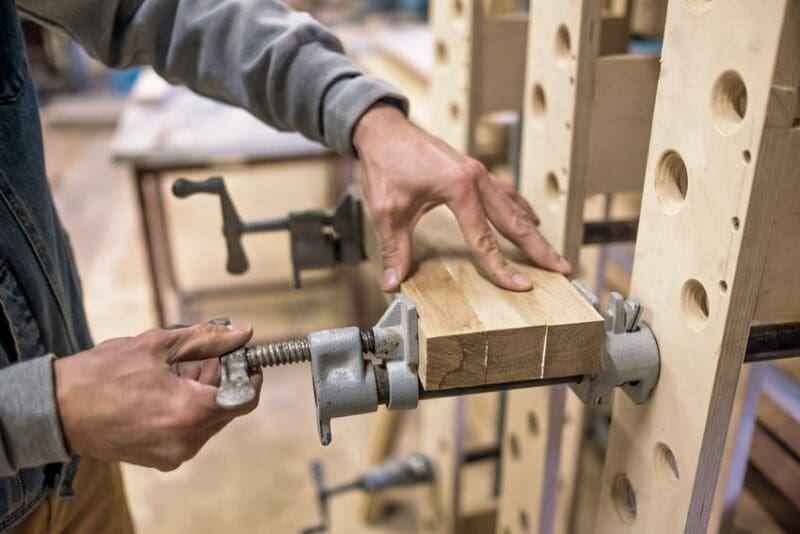
These characteristics make PVA glue ideal for securing wood joints, gluing boards together, or repairing split wood. While PVA may be the most common glue for wood, it does have its limitations. It isn’t very durable by itself and shrinks as it dries. This makes it a poor choice for filling holes or gaps. Since it soaks into the wood grain, most PVA glue is not stainable. It also typically takes a full day to cure, which can slow your carpentry project to a halt.
Polyurethane Glue
Often referred to as Gorilla glue, polyurethane glue is capable of gluing a variety of materials together. This makes it a great choice for bonding metal, ceramic, foam, and masonry, as well as wood (though it isn’t ideal for plastics). Since it doesn’t soak into the wood, it excels at making end grain connections, and it’s stainable. It also boasts a long open time of 15 minutes, giving you time to set up joints. Most polyurethane glue is also weatherproof and capable of withstanding extreme temperatures, making it a great choice for outdoor use. There are a few factors to consider when using polyurethane glue. Polyurethane requires moisture to cure, which means you’ll need to mist the surface of the wood before applying it. Since it expands as it dries, you’ll need to use clamps to ensure that it doesn’t push the pieces apart.
Epoxy
Epoxy glue comes in two parts, a resin and a hardener, which you mix as you’re applying the glue. This versatile glue works with metal, plastic, glass, tile, concrete, and ceramics along with wood. This makes it an ideal choice if you need to attach some other type of material to wood. Since epoxy dries to a very hard solid and won’t shrink or expand, it’s capable of filling holes and cracks.
As a waterproof material, epoxy wood glue is ideal for outdoor applications or even as a waterproofing sealer. While epoxy glue creates a very strong bond, the mixing process makes it notoriously messy to work with. Plus, it’s absolutely crucial that you get equal parts hardener and resin to ensure it dries to its full strength. Epoxies can vary in dry time from as little as 10 minutes up to several days depending on the type. Choose one with a drying time that suits your project.
Cyanoacrylate Glue
This clear colorless glue, often referred to as Super Glue or CA, is renowned for its ability to dry in seconds. We find it a staple in most households for miscellaneous quick repairs. CA glue is also a useful wood glue for joining molding or for quick furniture repair. In addition to wood, it also works with metal, plastic, and other types of common materials. Superglue dries to a hard translucent solid and doesn’t shrink. This makes it a good option for filling small holes and cracks in wood. CA glue comes in thin liquids and thicker gels to suit different types of applications.
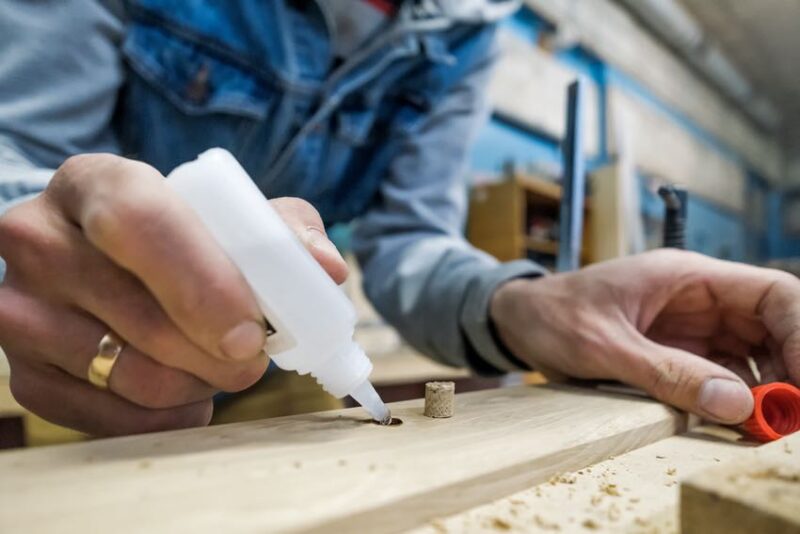
Hide Glue
Hide glue was common in woodworking for hundreds of years until the invention of synthetic glues. The origin of the expression, “sending the horse to the glue factory,” hide glue is traditionally made from animal skins. While manufacturers still use cow and pig hides in the production of this type of glue, much of today’s hide glues are made from recycled gelatin. PVA glue has largely replaced its use, but hide glue’s unique properties makes it a popular choice for certain types of woodworking. Woodworkers and craftsmen also love using it for furniture.
Unlike other wood glues, hide glue softens up when you apply heat. This makes it ideal for antique furniture restorations. Hide glue also resists glue creep. This occurs when the two glued pieces shift during the drying process or pull apart after it cures. It also has the unique ability to tighten joints between wood as it dries. Lastly, it features a long open time, which gives you more time for setting up larger, more complicated glue-ups. Hide glue is available ready-to-use or as a dry material that you mix and heat on the stove top.
Best Overall Wood Glue
Gorilla Wood Glue
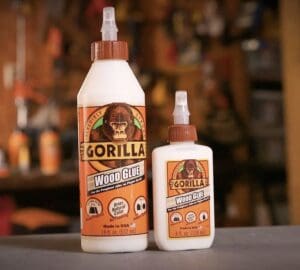
If there’s one wood glue you should have in your workshop, it’s this PVA yellow wood glue from Gorilla. Rated for indoor and outdoor use, Gorilla Wood Glue works with most hardwood, softwoods, and wood composites. It dries to a natural-looking tan color and remains sandable and paintable. This makes it—in our opinion—the best wood glue for most carpentry projects. We also like how easy it is to use.
With a 15-minute open time, you won’t have to rush to set up your clamps. Plus, it has a short dry time of 30 minutes, letting you move more quickly through projects. Once dry, Gorilla wood glue creates a tighter than average bond for a PVA wood glue with a tensile strength of 4000 psi. Gorilla Wood Glue also happens to be reasonably priced and has a decent shelf life when stored in a cool, dark place.
Best Polyurethane Glues: The Moisture-Activated Powerhouse
Titebond Polyurethane Glue
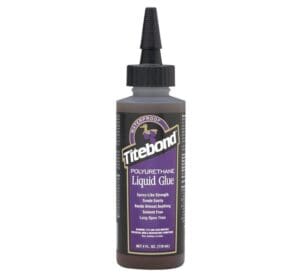
Titebond polyurethane glue bonds wood to virtually any other type of material. This includes ceramics, metal, stone products, and most plastic. We find it a great glue to reach for when attaching wood to another material. 100% waterproof, you can use Titebond for projects that will spend their days exposed to the elements.
And, unlike other polyurethane and PVA wood glues that have a 15-minute working time, Titebond gives you 30 minutes of open time. This gives you an advantage when dealing with more complicated glue ups. It dries quickly in just 45 minutes, so you can keep your project moving forward. Finally, it has a strong tensile strength of 3500 psi.
Best Epoxy Resins: For Heavy-duty Bonding
J-B Weld ClearWeld Epoxy
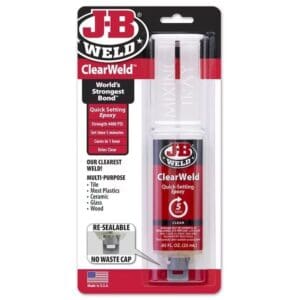
J-B Weld takes the mess and guesswork out of working with epoxy with its dual syringe design. The syringe squeezes out equal parts hardener and resin as you apply pressure to the plunger. This ensures you get the right ratio while giving you greater control over how much you use. Once both parts are in the included mixing tray, simply mix the two with the stir stick and apply.
J-B Weld gives you one of the strongest joints you can get with any wood glue with a tensile strength of 3900 psi. It works with a broad range of materials, including plastic, concrete, ceramics, and glass as well as wood. Its short open time of just 5 minutes, however, limits it to simple joints. Curing in just one hour, you won’t have a lot of downtime waiting for this glue to dry.
Best Cyanoacrylate (Super Glue): Quick Fixes and Small Projects
Starbond Super Fast Thin CA Glue
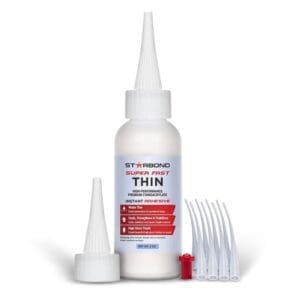
Creating a successful bond with CA glue requires some level of precision. This helps make Starbond such a great product as it comes with micro-tips. These, coupled with its water-like viscosity, let you apply that just-right amount of glue to make the perfect bond. Each long curved tip helps you apply glue in hard-to-reach connections.
Starbond dries in less than 5 seconds, making it ideal for quick repairs and joining smaller materials you can’t clamp. Once dry, it has a high gloss finish ideal for woodworking projects. Most cyanoacrylate glues end up with hopelessly clogged applicators, so we love the fact that Starbond includes plenty of replacements. Each pack comes with three applicator nozzles, two stoppers, and 16 micro-tips.
Best Hide Glues: The Traditional Choice
Titebond Liquid Hide Wood Glue
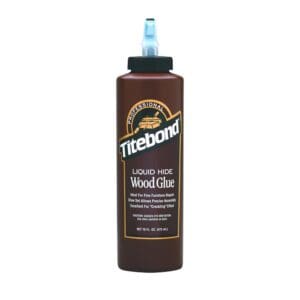
Though pricier than other wood glues, Titebond Liquid Hide Wood glue’s ability to create tight joints and its reversibility makes it a top choice for woodworkers and anyone making repairs to antique furniture or wood instruments. Easier to use than traditional hide glues, Titebond works right out of the bottle. There’s no need to mix it or heat it up on a stove top.
This also means there’s no funky smells to deal with either. It resists creeping better than PVA glues, making it easier to work with on most materials. Titebond hide glue has an open assembly time of 10 minutes, sands easily, and works well with finishes and stains. It also dries to a nice brown that blends well with most wood colors.
Best Wood Glue for Common Household Repairs
STARBOND Thick Super Glue
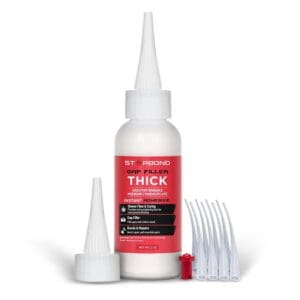
While Starbond earned its reputation in the woodworking world for its strength and high gloss finish, it’s also well suited for a variety of household repairs. It bonds a variety of materials, including wood, plastic, ceramics, metal, glass, and leather. You can find it in a variety of viscosities, making it suitable for a host of repairs around the house.
Starbond includes extra applicators and micro-tips, so you can avoid the frustrating applicator clogs common with CA glues. While Starbond costs more than many other CA glues, its versatility and ease-of-use make it worth the extra few dollars. Their Thick or “gap filler” super glue works wonders on items where you may encounter a .01–.02″ space that needs filling.
Best Wood Glue for Crafting and DIY Projects
Weldbond Multi-Surface Adhesive
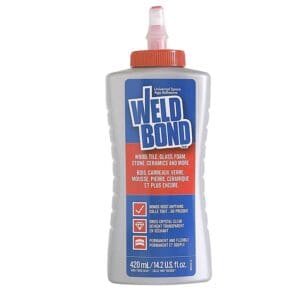
Forget everything we’ve told you about PVA glues when it comes to Weldbond. Unlike standard wood glue, which only works with wood material, Weldbond is a PVA glue. It works with just about everything. In addition to wood, use Weldbond on fabric, carpet, tile, metal, ceramics, masonry, foam, and a host of other materials.
This makes it usable for everything from carpentry projects to crafts and various repair jobs around the house. Since it is non-toxic and produces no fumes, it’s also an ideal choice for kid’s arts and crafts projects. Weldbond dries clear, is sandable and paintable, and is rated for outdoor use, adding to its versatility.
Best Wood Glue for Furniture Making and Restoration
Wonderlok’Em Tite Chairs Adhesive
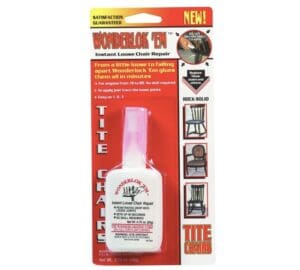
Normally, the only way to repair a wobbling table or wooden chair is to disassemble it and re-glue the joint. Not so with Wonderlok. This cyanoacrylate formula is thin enough to penetrate into tiny gaps in wood joints. Creating a bond with a tensile strength of 4000 psi, this adhesive remains stronger than the wood it holds together.
Like other cyanoacrylate glues, Wonderlok also works with metal, glass, rubber, fabric, and ceramics. You can use it to make repairs for other types of materials found on furniture.
Other Considerations When Choosing Wood Glue
Strength
Most glues are rated by tensile strength in pounds per square inch (psi). This measurement indicates how much pulling force the bond can endure before separating. This spec makes it easy to compare the strength of wood glues. Just keep in mind that using the right technique when gluing impacts the strength of the bond. Properly cleaning each surface, making an even application of glue, clamping the two pieces together (when possible), giving the bond time to cure properly, and applying it in the right weather conditions, will all ensure you get the strongest bond the glue offers.
Drying Time
There are a few factors to consider when thinking about drying time, including open time, drying, and curing time. Knowing the difference between the three is key to achieving a strong bond.
- Open time is the amount of time you have to work with the glue once it’s out of the bottle. After this, it begins to lose its ability to bond materials together. When a glue is open, you can still reset the joint, make adjustments to it, and apply clamps. Once the glue closes, however, the joint must remain completely stationary or you’ll compromise the bond. Wood glue open time ranges from 10 to 15 minutes. Most cyanoacrylate glues have an open time of just seconds.
- Drying time is how long you need to wait before the glue is dry enough that the joint no longer needs to be supported by clamps, your fingers, or other means. Wood glues typically dry in hours, while cyanoacrylate glues usually dry in seconds. Epoxies take just minutes. Keep in mind that dry time is not an indication of when you can expose the joint to stress. When dealing with a stressed joint, keep it clamped until the glue has fully cured.
- Cure time is the amount of time it takes until the glue has reached its maximum hardness and, hence, maximum tensile strength. This process can take hours or days depending on the type of glue. Once a glue has cured, you can expose the bond to the real world.
Shelf Life
While it’s nice to have a variety of glues at the ready whether it’s for a carpentry project or reattaching a piece to a child’s toy, you’ll want to pay attention to the shelf life of the glue. You don’t want to throw away a full bottle of expired glue! Many glue manufacturers list a year for the shelf life of their products. However, that doesn’t mean you can’t get more mileage out of most glues. Light, extreme temperatures, and moisture are the enemy of glue. If you store the glue in a cool, dry place at room temperature, instead of in an unfinished garage or shed, you can often significantly extend the life of most glues for years, including, PVA, epoxy, CA, and even hide glues.
Viscosity
How thick or thin a glue is determines how easy or difficult it is to work with certain projects. Glues with a thinner viscosity can better fit into tiny cracks. The downside? They tend to run when applied to vertical surfaces and are more difficult to spread over large surface areas. Thicker glues do a better job of defying gravity while still filling cracks or holes. They are easier to spread over joints that have a large surface area. Viscosity isn’t specific to any glue type. While PVA, hide, and polyurethane glues generally have a thick viscosity, CA and epoxy glues can be either thin or gel-like
Color
Wood glue varies in color when it dries. While some wood glue dries to a natural wood color, others dry to a translucent color. Since wood glue is often used to join finished pieces of carpentry, it may be visible on the project. In cases where the glue remains visible, choose a wood glue that dries to a color that closely matches the color of the wood. When using wood glue for a project you’re staining or painting, make sure you choose a glue that can take those materials.
Weather resistance
When choosing a glue for outdoor use, be sure to select one that’s waterproof. The American National Standards Institute (ANSI) rates glues for water resistance. Glues with a Type 1 rating are waterproof and therefore best suited for a life in the elements. Type 2 glues are only water-resistant and therefore not suitable for extended time outdoors.
Best for Large Projects
Gorilla Wood Glue
There are several reasons why Gorilla tops the list when it comes to larger carpentry or woodworking efforts. Its thicker viscosity makes it easier to spread over broad areas than thinner glues. Gorilla Glue also has an open time of up to 15 minutes. That gives you plenty of time for joining multiple large pieces of wood and setting up clamps.
Once together, Gorilla Glue creates a tighter bond than your average PVA wood glue with a tensile strength of 3900 to 4000 psi. This level of holding strength means it will hold your project together even when the wood around it has failed! Gorilla Glue also won’t take up a large chunk of your project’s budget. It’s one of the more affordable wood glue options out there.
Strongest Hold
Titebond III Ultimate Wood Glue
True to its name, Titebond III Ultimate tops our list when it comes to PVA wood glue offering the strongest hold. When used as directed, you’ll get a bond with a tensile strength of 4000 psi. This maxes out the best you can get from this type of glue. Titebond III is the glue of choice for projects with stressed joints, such as those found in shelving, cabinetry, and other wood furniture. It also has other qualities that make it easier to work with. In particular, we like the long open time of 8 to 10 minutes and its strong initial tack between joints.
Fastest Drying
Krazy Glue Wood Glue
You typically clamp two materials together to hold them in place as the glue takes its time drying. While ideal for many carpentry projects, this sometimes isn’t possible. When you have items that are too small and delicate or too irregularly shaped to clamp, or you simply don’t want to wait hours for the glue to dry, Krazy Glue Wood Glue’s quick dry time is your best bet. Krazy Wood Glue’s 2-minute open time is longer than other CA glues. This gives you a little more time to set up the joint, yet it still dries in just 6 minutes. Krazy Glue also works with a broad range of softwoods and hardwoods, including pine, oak, and maple, among others.
Best for Outdoor Use
Grizzly Glue Xpress Construction and Wood Glue
While most PVA wood glues are water-resistant, few are strong enough to endure prolonged exposure to water and extreme temperatures. Grizzly Glue is a notable exception. Its formula is 100 percent waterproof, and it works with metal, stone, tile, and glass, as well as wood. Use it for a variety of outdoor applications. With its excellent tack, Grizzly Glue Xpress also proves ideal for vertical joints. This cartridge-based glue has an open time of 8 to 10 minutes, giving you time to set up your connection. It fully cures in about five hours, so you won’t have to sweat it if unexpected foul weather threatens.
Best Budget Wood Glue
Elmer’s E7000 Carpenter’s Wood Glue
If you’re on a budget, you could certainly do worse than Elmer’s E7000 Carpenter’s Wood Glue. A small bottle costs just a couple of dollars. While it may not match the performance of top tier PVA wood glues, it’s more than adequate for most projects. Elmer’s wood glue works with softwoods and hardwoods, dries to a natural color, and is sandable and paintable (though it’s not stainable). Since it only requires a short clamp time of just 20 to 30 minutes, you won’t have a lot of downtime waiting for it to dry.
Frequently Asked Questions (FAQs) about Best Wood Glue
Is wood glue stronger than screws or nails?
Believe it or not, wood glue actually has more holding strength than screws or nails in many situations. Whereas metal fasteners only create a physical connection between two pieces of wood at the point where you nail them or drive them in, wood glue actually soaks into the wood fibers and creates a chemical connection along the entire joint. This gives you a stronger bond with more rigidity than what screws or nails can achieve by themselves.
How long should I clamp wood after gluing?
How long you need to clamp two pieces of wood together after gluing depends on whether the connection is a stressed or unstressed joint. For unstressed joints, typically 30 minutes is enough time for the glue to set. However, when clamping together a stressed joint, keep those clamps in place for a full 24 hours before removing them. Of course, it’s always a good idea to consult with the glue manufacturer instructions when determining clamp time.
Can wood glue be used on other materials?
Whether you can use wood glue on other materials or not depends on the brand. Epoxy, polyurethane, and CA wood glue usually works with metal, plastic, stone, and other materials in addition to wood. Most PVA and hide glues are for wood only, though some work with a variety of materials. Always check the glue’s label for a list of compatible materials.
Is it possible to stain or paint over wood glue?
While you can paint over most PVA wood glues, they don’t support staining. Wood glue works by soaking into the wood grains to create a chemical bond between the two pieces being joined. Since stain works by soaking into the porous wood grain, it won’t be able to penetrate the wood since the glue is already filling these pockets in the wood. Paint sits on the surface of wood, which is why most wood glues are paintable.
How do I remove dried wood glue from surfaces?
To remove dried wood glue from a surface, first heat the glued area using a heat gun or hair dryer. If you don’t have either, warm up a damp rag in the microwave then hold it against the dried glue. The heat will help to soften the glue, making it easier to remove. Next, use a rag to wipe the glue from the surface. If it’s still partially solid, you can also use a plastic scraper to remove it. No heat gun or hair dryer? If you have any nail polish remover handy, try soaking the end of a cloth in the acetone, then rub it over the dried glue to remove it. Just be sure to test an inconspicuous area first to avoid ruining your project.

